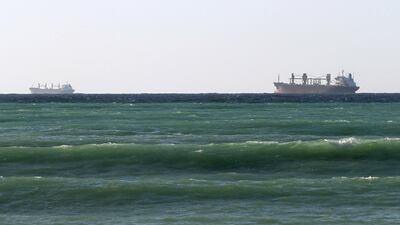A series of four explosions struck an Israeli-owned cargo ship sailing out of the Middle East on Friday, renewing concerns about ship security in the region amid escalating tensions between the US and Iran.
The crew and vessel were safe, according to the United Kingdom Maritime Trade Operations, which is run by the British navy. The explosion in the Gulf of Oman forced the vessel to head to the nearest port.
The incident recalled the summer of 2019, when the same site saw a series of suspected attacks that the US Navy blamed on Iran, which Tehran denied. Meanwhile, as President Joe Biden tries to revive nuclear negotiations with Iran, he ordered overnight airstrikes on facilities in Syria belonging to a powerful Iranian-backed Iraqi armed group.
Dryad Global, a maritime intelligence firm, identified the stricken vessel as the MV Helios Ray, a Bahamian-flagged roll-on, roll-off vehicle cargo ship. Another private security official, who spoke to The Associated Press on condition of anonymity to discuss intelligence matters, similarly identified the ship as the Helios Ray.
Analysing photos of damage to the inside of the vessel, maritime security firm Ambrey Intelligence said pictures showed damage above the water line consistent with limpet mines, small magnetic explosive devices attached to the hull. There was no way to independently verify the images.
Satellite-tracking data from website MarineTraffic.com showed the Helios Ray had been nearly entering the Arabian Sea around 0600 GMT on Friday before it suddenly turned around and began heading back toward the Strait of Hormuz. It was coming from Dammam, Saudi Arabia, and still listed Singapore as its destination on its tracker.
Israel’s Channel 13, in an unsourced report, said the assessment in Israel is that Iran was behind the blast. Israeli officials did not immediately respond to requests for comment. The Iranian government did not comment on the blast Friday.
The blast comes as Tehran increasingly breaches its 2015 nuclear accord with world powers to create leverage over Washington. Iran is seeking to pressure Mr Biden to grant the sanctions relief it received under the deal that former president Donald Trump abandoned nearly three years ago.
Iran also has blamed Israel for a recent series of attacks, including a mysterious explosion last summer that destroyed an advanced centrifuge assembly plant at its Natanz nuclear facility and the killing of Mohsen Fakhrizadeh, a top Iranian scientist who founded the Islamic Republic’s military nuclear program two decades ago.
Capt Ranjith Raja of the data firm Refinitiv told the AP that the Israeli-owned vessel had left the Arabian Gulf on Thursday bound for Singapore. On Friday at 0230 GMT, the vessel stopped for at least nine hours east of a main Omani port before making a 360-degree turn and sailing toward Dubai, likely for damage assessment and repairs, he said.
The vessel came loaded with cargo from Europe. It discharged vehicles at several ports in the region, Capt Raja said, including in Bahrain, the United Arab Emirates and Saudi Arabia, with its last port of call at Dammam.
While details of the explosion remained unclear, two American defence officials told the AP that the ship had sustained two holes on its port side and two holes on its starboard side just above the waterline. The officials said it remained unclear what caused the holes. They spoke to the AP on condition of anonymity to discuss unreleased information on the incidents.
A United Nations ship database identified the vessel’s owners as a Tel Aviv-based firm called Ray Shipping.
Abraham Ungar, 74, who goes by “Rami,” is the founder of Ray Shipping, and is known as one of the richest men in Israel. He made his fortune in shipping and construction.
According to the Nikola Y Vaptsarov Naval Academy, where Mr Ungar provides support and maritime training, he owns dozens of car-carrying ships and employs thousands of engineers.
The US Navy’s Bahrain-based 5th Fleet said it was “aware and monitoring” the situation. The US Maritime Administration, an agency of the Transportation Department, issued a warning to commercial shippers early on Saturday acknowledging the explosion and urging ships to “exercise caution when transiting” the Gulf of Oman.
While the circumstances of the explosion remain unclear, Dryad Global said it was very possible the blast stemmed from “asymmetric activity by Iranian military”.
As Iran seeks to pressure the United States to lift sanctions, the country may seek “to exercise forceful diplomacy through military means”, Dryad reported.
Previous Iranian attacks
In the tense summer of 2019, the US military blamed Iran for explosions on two oil tankers near the Strait of Hormuz, one of the world’s most strategic shipping lanes. The US also attributed a series of other suspected attacks to Iran, including the use of limpet mines to cripple four oil tankers off the nearby Emirati port of Fujairah.

Since the killing of Fakhrizadeh, the Iranian nuclear scientist, last November, Israeli officials have raised alarms about potential Iranian retaliation, including through its regional proxies such as Lebanon’s Hezbollah and Yemen’s Houthi rebels.
Over the years, Iran has been linked to attacks on Israeli and Jewish civilian targets in Latin America, Europe and Asia. Israel has not commented on its alleged role in the scientist’s killing.
Friday’s incident also follows normalisation deals between Israel and the UAE and Bahrain. The agreements, criticised by Iran, solidified an emerging regional alliance against the Islamic Republic.

